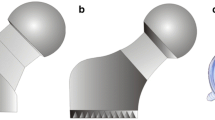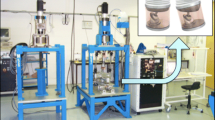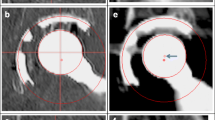Abstract
Purpose
Dual mobility was introduced by Pr. G. Bousquet to improve the dislocation risk of total hip arthroplasty (THR). The wear mechanisms of this implant remain to be understood. Could enhanced explant wear analysis explain liner wear behaviour?
Methods
Sixty-six explanted liners were selected. Non-destructive 3D scanning and heat colour treatment allowed reporting wear patterns on both convex and concave sides of the liners.
Results
For many liners, liner convexity wear was found to be homogeneous, and linked to a longer implantation time. A few liners had signs of blocking of the convexity, leading to excessive internal damage. Intra prosthetic dislocations were found to only have internal circular wear without liner penetration.
Conclusion
Heat colour treatment showed its effectiveness for highlighting wear patterns. Optimal convexity mobility seemed to be leading to a longer implantation time, with decreased contact stresses on concavity. The retentive rim should have a distinct wear analysis.





Similar content being viewed by others
References
Boyer B, Philippot R, Geringer J, Farizon F (2012) Primary total hip arthroplasty with dual mobility socket to prevent dislocation: a 22-year follow-up of 240 hips. Int Orthop 36:511–518. doi:10.1007/s00264-011-1289-4
Dumbleton JH, Manley MT, Edidin AA (2002) A literature review of the association between wear rate and osteolysis in total hip arthroplasty. J Arthroplasty 17:649–661
Massin P, Orain V, Philippot R et al (2012) Fixation failures of dual mobility cups: a mid-term study of 2601 hip replacements. Clin Orthop 470:1932–1940. doi:10.1007/s11999-011-2213-3
Lecuire F, Benareau I, Rubini J, Basso M (2004) Intra-prosthetic dislocation of the Bousquet dual mobility socket. Rev Chir Orthop Réparatrice Appar Mot 90:249–255
Philippot R, Boyer B, Farizon F (2013) Intraprosthetic dislocation: a specific complication of the dual-mobility system. Clin Orthop Relat Res 471:965–970. doi:10.1007/s11999-012-2639-2
Fabry C, Langlois J, Hamadouche M, Bader R (2016) Intra-prosthetic dislocation of dual-mobility cups after total hip arthroplasty: potential causes from a clinical and biomechanical perspective. Int Orthop 40(5):901–906
Geringer J, Boyer B, Farizon F (2011) Understanding the dual mobility concept for total hip arthroplasty. Investigations on a multiscale analysis-highlighting the role of arthrofibrosis. Wear 271:2379–2385. doi:10.1016/j.wear.2011.02.027
Engh CA, Claus AM, Hopper RH, Engh CA (2001) Long-term results using the anatomic medullary locking hip prosthesis. Clin Orthop 137–146
Eingartner C, Heigele T, Volkmann R, Weise K (2006) Long-term results of an uncemented straight femoral shaft prosthesis. Hip Int J Clin Exp Res Hip Pathol Ther 16:23–32
Eskelinen A, Remes V, Helenius I et al (2006) Uncemented total hip arthroplasty for primary osteoarthritis in young patients: a mid-to long-term follow-up study from the Finnish Arthroplasty Register. Acta Orthop 77:57–70. doi:10.1080/17453670610045704
Grant P, Nordsletten L (2004) Total hip arthroplasty with the Lord prosthesis. A long-term follow-up study. J Bone Joint Surg Am 86-A:2636–2641
Hallan G, Lie SA, Furnes O et al (2007) Medium- and long-term performance of 11,516 uncemented primary femoral stems from the Norwegian arthroplasty register. J Bone Joint Surg Br 89:1574–1580. doi:10.1302/0301-620X.89B12.18969
Bennett D, Humphreys L, O’Brien S et al (2008) Wear paths produced by individual hip-replacement patients—a large-scale, long-term follow-up study. J Biomech 41:2474–2482. doi:10.1016/j.jbiomech.2008.05.015
Lee K-Y, Kim S-Y, Shin D et al (2004) Wear of retrieved UHMWPE hip liners. Yonsei Med J 45:293–299
Wroblewski BM, Siney PD, Fleming PA (2009) The principle of low frictional torque in the Charnley total hip replacement. J Bone Joint Surg Br 91:855–858. doi:10.1302/0301-620X.91B7.22027
Yamaguchi M, Bauer TW, Hashimoto Y (1997) Three-dimensional analysis of multiple wear vectors in retrieved acetabular cups. J Bone Joint Surg Am 79:1539–1544
Philippot R, Meucci JF, Boyer B, Farizon F (2013) Modern dual-mobility cup implanted with an uncemented stem: about 100 cases with 12-year follow-up. Surg Technol Int 23:208–212
Caton JH, Prudhon JL, Ferreira A et al (2014) A comparative and retrospective study of three hundred and twenty primary Charnley type hip replacements with a minimum follow up of ten years to assess wether a dual mobility cup has a decreased dislocation risk. Int Orthop 38(6):1125–1129. doi:10.1007/s00264-014-2313-2
Prudhon JL, Steffann F, Ferreira A et al (2014) Cementless dual-mobility cup in total hip arthroplasty revision. Int Orthop 38:2463–2468. doi:10.1007/s00264-014-2448-1
Leclercq S, Benoit JY, de Rosa JP et al (2013) Evora® chromium-cobalt dual mobility socket: results at a minimum 10 years’ follow-up. Orthop Traumatol Surg Res OTSR 99:923–928. doi:10.1016/j.otsr.2013.07.017
Charnley J, Kamangar A, Longfield MD (1969) The optimum size of prosthetic heads in relation to the wear of plastic sockets in total replacement of the hip. Med Biol Eng 7:31–39
Matsen Ko LJ, Pollag KE, Yoo JY, Sharkey PF (2016) Serum metal ion levels following total hip arthroplasty with modular dual mobility components. J Arthroplasty 31:186–189. doi:10.1016/j.arth.2015.07.035
Author information
Authors and Affiliations
Corresponding author
Ethics declarations
Conflict of interest
Bertrand Boyer was a consultant for SERF (Décines, France). Thomas Neri is a consultant for SERF (Décines, France). Rémi Philippot and Frédéric Farizon receive royalties from SERF (Décines, France). Alexandre Di Iorio and Jean Geringer had no conflict of interest concerning this study.
Rights and permissions
About this article
Cite this article
Boyer, B., Neri, T., Geringer, J. et al. Understanding wear in dual mobility total hip replacement: first generation explant wear patterns. International Orthopaedics (SICOT) 41, 529–533 (2017). https://doi.org/10.1007/s00264-016-3362-5
Received:
Accepted:
Published:
Issue Date:
DOI: https://doi.org/10.1007/s00264-016-3362-5




